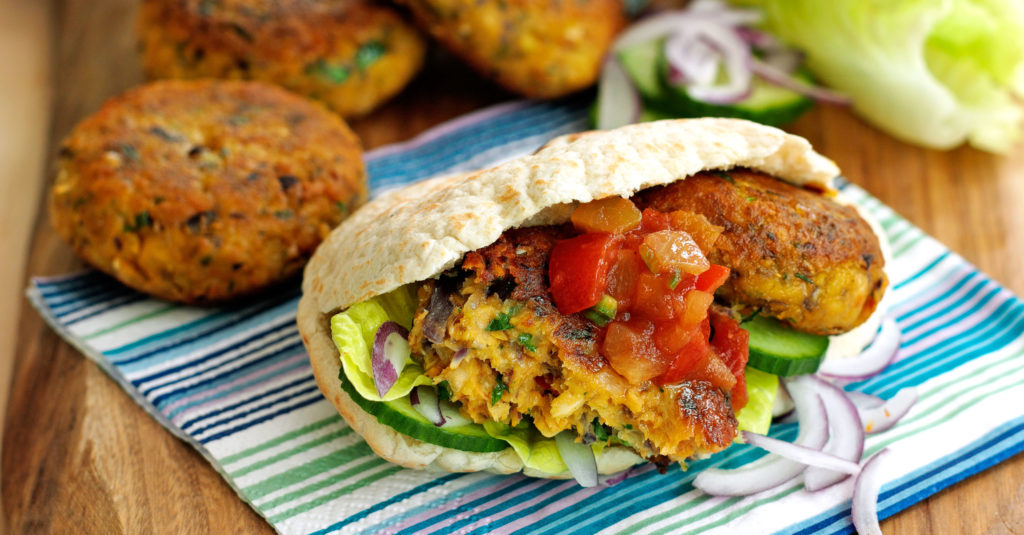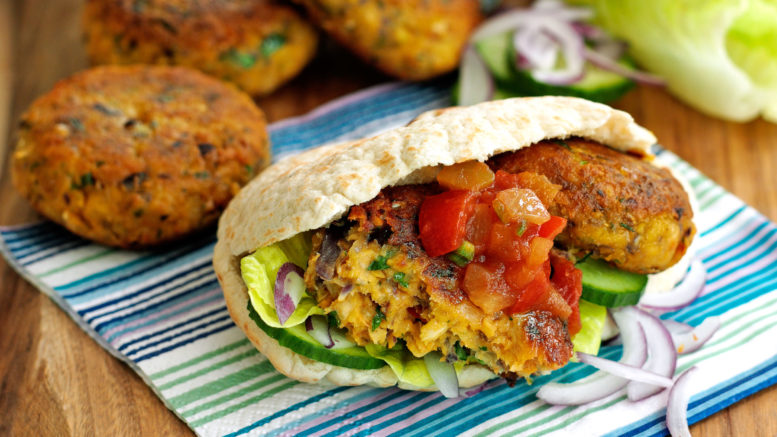
Pronounce it: Fill-aff–ill
An age-old mainstay of fast street food in virtually every Arabic-speaking and Eastern Mediterranean country, falafel is now firmly established in the West. Traditionally, small patties based on minced ful (dried broad beans) or on chickpeas are served direct from a vat of boiling oil into warm bread – a wrap or a split pitta perhaps – together with fresh salad ingredients. Classic falafel are ball-shaped, sometimes slightly flattened, but modern falafel shapers make shallow cylinders, like small, thick hamburger shapes. Crisp and golden brown on the outside, warm and pale greenish on the inside, redolent with a gentle flavouring of herbs and spices, they are vegetarian food at its greatest.
Availability
If you use raw or canned chickpeas they are simple to make and to enjoy at home. Dried ful – the only beans native to the Western world – are increasingly available on line and in Middle Eastern shops.
Ready-made falafel are widely offered commercially in the UK. The ingredients, size and variety of shapes made and suggested are infinite.
Store it
The raw minced mixture is sometimes allowed to rest to integrate the flavours and textures, ideally refrigerated. Use the uncooked mixture within a day: cooked, refrigerated falafel should be eaten within three days. Bought ones should be kept refrigerated and heated and eaten strictly according to printed instructions.
Cook it
Super-traditionalists, especially those from Alexandria in Egypt, say falafel should be made only with dried ful. Strange to European thought, falafel are made there with beans that are soaked overnight but not cooked. This ensures a slight texture, which is often missing from other versions.
In the UK, chickpeas
are the most common basis. These are usually precooked, which precludes
texture in the final product, although some commercial producers use
soaked but not cooked chickpeas, giving potential texture but a
background of raw pea flavour. A combination of cooked chickpeas and
some soaked ful seems to be an excellent thing.
Parsley,
coriander leaf, cumin, coriander seeds and green (Spring) onion are the
other most common ingredients, used according to individual preference.
Finely minced white onion is used in many UK versions and these
sometimes avoid coriander leaf on the basis that the UK palate hasn’t
quite accepted this yet.
Not unexpectedly, creative Westerners now add such other ingredients as olives, sun-dried tomatoes and the inauthentic but inevitable heat of chillies but it’s better to use more flavoursome chili (note spelling) powder, which includes more cumin and oregano. Or to use such Eastern Mediterranean flavourings as sumac, baharat, ras el hanout and so on. Crumbled feta cheese is an excellent addition.
Although a perfect picnic or anytime snack when cold, falafel are very much better when warm. Reheat in an oven; brief microwaving will soften any crust but gratify your hunger faster.
The choice of accompanying sauces is enormous. Houmous or tahini, of course, but tomato sauces, yoghurt-based sauces, mayonnaise sauces, smoky barbecue sauces, chilli-hot sauces and squeezes of lemon or lime juice are all good.
Pioneering BBC-TV Chef Glynn Christian is author of REAL FLAVOURS – the Handbook of Gourmet and Deli Ingredients, voted ‘World’s Best Food Guide’.

Be the first to comment on "Falafel"